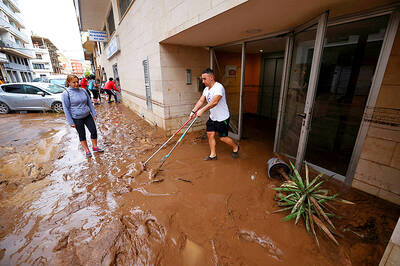The jumpy video shows a prisoner lying in a jungle clearing in eastern Indonesia moments after troops allegedly sliced open his abdomen with a bayonet, sending intestines tumbling from his stomach.
Using the little life he has left in him, Yawen Wayeni lifts his arm into the air, and says weakly: “Freedom! Papua ... Freedom!”
At the sound of his muffled voice, gun-toting, uniformed officers resting in the shade approach.
“Speak up,” one taunts. “What? You all are never going to get freedom. As long as there are soldiers still.”
One year after the activist’s death, footage being circulated online is providing a glimpse into the actions of Indonesia’s military in Papua, where an estimated 100,000 people have been killed since the former Dutch colony was integrated into the country nearly 50 years ago.
A low-level insurgency in the province remains an extremely sensitive issue for the government, which restricts access to foreign journalists, human rights workers and academics, making it difficult to verify claims of abuse.
Police have said Wayeni, captured for allegedly vandalizing several of their buildings and vehicles, was shot in the thigh and stomach while resisting arrest and that he died on the way to the hospital.
Harkristuti Harkrisnowo, a director general at Indonesia’s Ministry of Law and Human Rights, said on Tuesday she was unaware of the video but promised to investigate.
DEMOCRACY
Indonesia has made tremendous strides toward democracy since emerging from decades of dictatorship under General Suharto in 1998. Citizens today can vote directly for president and the country has been praised for reforms that have freed the media and vastly improved human rights.
But government critics in Papua are still given lengthy prison terms for peacefully expressing their views, organizing rallies or simply raising separatist flags. Many say they have been tortured in detention with electric shocks, beatings and cigarette burns.
The central government, which granted Papua special autonomy in 2001, denies such atrocities still take place. An Amnesty International report cited incidents of torture, excessive force and executions by security forces in Papua last year.
Others said the killing points to the persistence of violence in governing the far-flung, desperately poor region.
“For all their talk about how things have changed since Suharto’s days, this particular murder is just another example reminding us how much remains the same,” said Richard Chauvel, a senior lecturer at Victoria University in Australia who has written extensively about Papua.
The video also points to broader feelings that special autonomy — which gives Papuans greater control over their budget and economy — has done little to address key issues driving attitudes in the province.
Sidney Jones of the International Crisis Group, a Brussels-based think tank, said government leaders, with few exceptions, “do not understand that the only way to stem an independence movement is through serious attention to political issues.”
“At the same time, the Papuans themselves tend to blame Jakarta for everything that has gone wrong, without too much introspection what they themselves could do,” Jones said.
This is a huge gap, she said, that can only be bridged if high-level discussions are held about political issues.
Others believe outside pressure is required.
Fifty members of the US Congress signed a letter calling on US President Barack Obama to make Papua — the half of New Guinea that was invaded by Indonesia in 1962 — “one of the highest priorities of the administration.”
Even so, as part of efforts to shore up influence in the region amid increasing challenges from China, Washington last month lifted a decade-long ban on military assistance to a notoriously violent commando unit, known as Kopassus, which operates in Papua.
The seven-minute video appears to have been made by the Korps Brigade Mobil, the paramilitary police who took part in the arrest. It too has a legacy of abuse in Papua.
It’s not clear how the clip made its way to the Internet, and few here have seen it.
The troops caught up with Wayeni at his home in the jungle village of Matembu on Aug. 3 last year.
‘FREE PAPUA!’
Wayeni’s wife told the Commission for Disappearances and Victims of Violence that they tied his arms and legs to a log and forced him to chant “Free Papua!” before slicing him in the abdomen with a bayonet.
They all but ignored him as he stumbled to the ground, landing in a patch of rough grass and propping his head up on a log.
“Look, he’s tired,” one officer says as the prisoner’s head lolls back, his eyes rolling.
The police ask Wayeni if he is an atheist and call him a “savage,” saying his prayers will never be answered. They then ask how, in his condition, he thinks Papua will ever shake free of Indonesian rule.
“It’s equally surreal and horrific watching as the grievously injured Yawan Wayeni answers teasing questions from uniformed Indonesia security forces about his political beliefs,” said Phil Robertson, a deputy director at the New York-based Human Rights Watch.
Getting medical help, he said, seems the furthest thing from their minds.
Despite his suffering, however, the dying man refuses to give in.
“This land was promised by God to us, the Papuan people,” Wayeni says. “God, the suffering of the simple people, there are so many! They are crying, oh God!”

Police in China detained dozens of pastors of one of its largest underground churches over the weekend, a church spokesperson and relatives said, in the biggest crackdown on Christians since 2018. The detentions, which come amid renewed China-US tensions after Beijing dramatically expanded rare earth export controls last week, drew condemnation from US Secretary of State Marco Rubio, who on Sunday called for the immediate release of the pastors. Pastor Jin Mingri (金明日), founder of Zion Church, an unofficial “house church” not sanctioned by the Chinese government, was detained at his home in the southern city of Beihai on Friday evening, said

Floods on Sunday trapped people in vehicles and homes in Spain as torrential rain drenched the northeastern Catalonia region, a day after downpours unleashed travel chaos on the Mediterranean island of Ibiza. Local media shared videos of roaring torrents of brown water tearing through streets and submerging vehicles. National weather agency AEMET decreed the highest red alert in the province of Tarragona, warning of 180mm of rain in 12 hours in the Ebro River delta. Catalan fire service spokesman Oriol Corbella told reporters people had been caught by surprise, with people trapped “inside vehicles, in buildings, on ground floors.” Santa Barbara Mayor Josep Lluis

The Venezuelan government on Monday said that it would close its embassies in Norway and Australia, and open new ones in Burkina Faso and Zimbabwe in a restructuring of its foreign service, after weeks of growing tensions with the US. The closures are part of the “strategic reassignation of resources,” Venezueland President Nicolas Maduro’s government said in a statement, adding that consular services to Venezuelans in Norway and Australia would be provided by diplomatic missions, with details to be shared in the coming days. The Norwegian Ministry of Foreign Affairs said that it had received notice of the embassy closure, but no

A missing fingertip offers a clue to Mako Nishimura’s criminal past as one of Japan’s few female yakuza, but after clawing her way out of the underworld, she now spends her days helping other retired gangsters reintegrate into society. The multibillion-dollar yakuza organized crime network has long ruled over Japan’s drug rings, illicit gambling dens and sex trade. In the past few years, the empire has started to crumble as members have dwindled and laws targeting mafia are tightened. An intensifying police crackdown has shrunk yakuza forces nationwide, with their numbers dipping below 20,000 last year for the first time since records